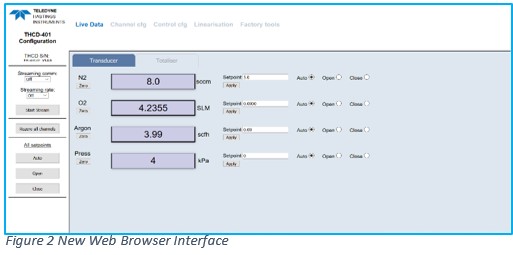What is a Thermocouple Gauge?
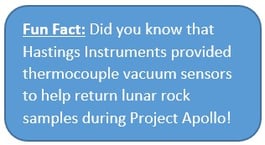
Teledyne Hastings was founded in 1944 as “The Hastings Instrument Company” by Charles and Mary Hastings. The introduction of thermal sensing technology in late 1940s at the young company offered potential for a variety of new technologies and quickly became the foundation for many early Hastings’ instruments. Early products included air velocity indicators, thermal mass flow meters, stack emission monitors and, of course, the thermocouple vacuum gauge tube.
By 1964, Hastings Instruments had grown into one of the leading vacuum and thermal mass flow instrument companies in America. Today, our popular Thermocouple Vacuum Gauge Tube product lines, including the DV-4, DV-5, and DV-6, are trusted globally where repeatable, rugged, and dependable pressure measurement is needed. Based in Hampton, Virginia for over 75 years, the highly-skilled employees at Teledyne Hastings are dedicated to delivering thermocouple vacuum gauges of exceptional quality.
How does a thermocouple gauge tube work?
The physics behind how a thermocouple vacuum gauge tube functions is simple. For example, let’s look at the DV-6R thermocouple vacuum gauge tube, which is capable of pressure measurements within the range of 0 – 1000 mTorr. The DV-6R can be seen in the image below, along with the representative schematic.
 |
 |
A thermocouple consists of a junction of two dissimilar filaments that are soldered together. Three thermocouples are shown (A, B, and C) in the DV-6R diagram, and many thermocouple gauge tubes use multiple thermocouples to form a thermocouple array. At each junction, there is a small voltage (on the order of a mv) which is a function of temperature. When the gauge tube is in operation, thermocouples A and B are resistively heated inside the gauge tube’s housing. Because each filament connected to both A and B thermocouples is exposed to the gas in the vacuum, thermal energy is transferred away from the array at a rate which is dependent on the number of collisions between the gas molecules and the filament wires. This transfer of thermal energy is, in turn, dependent on the pressure inside the tube. In essence, by measuring the rate of thermal energy transfer, the pressure inside of the tube is indirectly determined!
To understand the concept more fully, let’s consider two extremes. In high vacuum, where the pressure is very low, there will be fewer gas molecules to collide with each filament and the tube’s voltage output will be relatively high. Higher temperature corresponds to higher thermocouple output. As we approach near atmospheric pressure (760 torr), there are more gas molecules, resulting in more thermal energy transferred away from the filament. Consequently the thermocouples run at a lower temperature resulting in a relatively low output. The varying output produced by the thermocouple gauge is dependent on the thermal conductivity of the gas in the vacuum system, which is then used to measure pressure.
Thermocouple vacuum gauges are “indirect gauges”, meaning they accomplish pressure measurement by measuring a physical property, such as thermal conductivity or ionization rate of gas molecules, to determine the pressure in a vacuum system.
How to use a thermocouple vacuum gauge tube:
Teledyne Hastings’ vacuum gauge tubes are manufactured to the highest quality and tested to be extremely repeatable from one gauge tube to another to ensure accurate process control. Thermocouple vacuum gauge tubes are physically installed on a vacuum system and then used to measure various pressures across the tube’s full scale range. When the filament inside the tube is excited, the output is then converted to a pressure measurement.
An example gauge tube installation would consist of a DV-6R thermocouple vacuum gauge tube connected to a DCVT-6 panel meter or HPM-4/5/6 handheld meter. Both the DCVT-6 and HPM-4/5/6, are factory configured to work seamlessly with DV-6R gauge tubes, out of the box. The output from the gauge tube is then monitored by the DCVT-6 or HPM-4/5/6 and the level of vacuum displayed.
In the case of the DCVT, two contact relays are available for process control, and the dual relays will independently toggle according to user-defined setpoints, when the vacuum setpoint has been crossed. This demonstrates how the factory-tested repeatability of our gauge tubes results in consistent and repeatable process control! The DCVT also provides serial communication (RS232), LabVIEW™ drivers and linearized analog output options (0-1 VDC, 0-5 VDC, 0-10 VDC, 4-20 mA).
Related Products
| Teledyne Hastings' Vacuum Products | |||
| DCVT-6 | HPM 4/5/6 | DV-6R | DV-6S |
 |
|
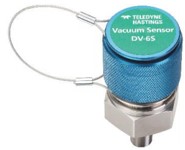 |
|
Application Example:
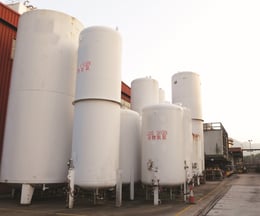 There are numerous, diverse vacuum applications and different vacuum systems can require specific thermocouple vacuum gauge tubes. At the most basic level, vacuum systems can be installed in a variety of environments including outdoor with exposure to weather elements, indoor industrial and laboratory conditions in which exceptionally high cleanliness standards are required.
There are numerous, diverse vacuum applications and different vacuum systems can require specific thermocouple vacuum gauge tubes. At the most basic level, vacuum systems can be installed in a variety of environments including outdoor with exposure to weather elements, indoor industrial and laboratory conditions in which exceptionally high cleanliness standards are required.
A good example of how a thermocouple vacuum gauge tube meets the requirements of a specific application, is presented in the vacuum insulation or vacuum jacketing field. The technique of using a vacuum guard or barrier to thermally insulate a cryogenic or refrigerant tank is straightforward: by removing the air from around an object, conductive heat transfer is eliminated. The better the vacuum attained, the higher the level of vacuum insulation. To effectively measure pressure below the 1 Torr range, a vacuum dial gauge is simply not sensitive enough; a thermocouple vacuum gauge tube is required.
To obtain vacuum readings from DV-6 gauge tubes, a dedicated electronic display or handheld battery-operated readout is used. The Teledyne Hastings’ DCVT provides continuous monitoring via an easy to read LED display. For periodic vacuum monitoring of one or more tubes, the hand-held HPM 4/5/6 is recommended because of its portability (9V battery power) and its ability to be quickly connected to a DV-6 tube and obtain an accurate reading with fast response time. To ensure the most accurate measurement, the DB-20 Reference Tube can be used to validate the electronic calibration. This can assist in determining if the thermocouple vacuum gauge tube requires replacement by ensuring that it is producing an accurate reading.
For more information about any of our thermocouple sensor series or vacuum gauges, we are here to help. In addition to LiveChat on our website, you can contact us at hastings_instruments@teledyne.com or call 757-723-6531 (800-950-2468) or click the button below.




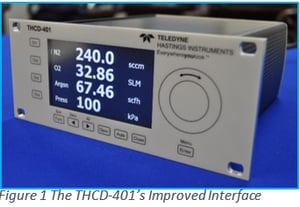 Teledyne Hastings is proud to announce our newest 4-channel power supply, controller and display, the
Teledyne Hastings is proud to announce our newest 4-channel power supply, controller and display, the  The addition of Ethernet communication provides access to the newest feature that the THCD-401 has to offer; the internal web server! The web server can be accessed by entering the IP address of the THCD-401 into a browser’s address bar (requires static IP address configuration on the network prior to use). While the web server feature works best in Mozilla™ Firefox®, it can be accessed via any browser you choose. Figure 2 shows the web server interface with applications along the top navigation bar and a live data stream for remote read.
The addition of Ethernet communication provides access to the newest feature that the THCD-401 has to offer; the internal web server! The web server can be accessed by entering the IP address of the THCD-401 into a browser’s address bar (requires static IP address configuration on the network prior to use). While the web server feature works best in Mozilla™ Firefox®, it can be accessed via any browser you choose. Figure 2 shows the web server interface with applications along the top navigation bar and a live data stream for remote read.